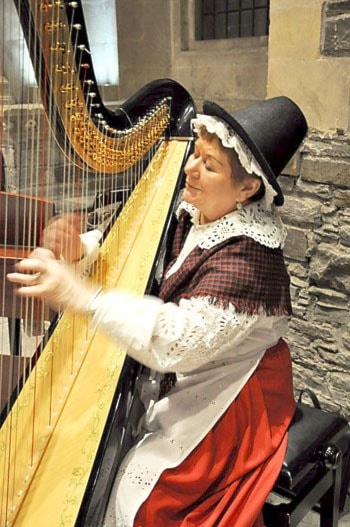Prince William and his fiancée, Kate Middleton, may have chosen to live in North Wales to be close to his Anglesey RAF base, or, perhaps, the Welsh being less sentimental about the English might give them some peace. I simply chose it for the castles.
Having trudged through my share of castles down the decades, I’m surprised to find myself captivated by the elegance and power of Conwy Castle.
Eight commanding towers crown the headland of the medieval town scattered along the Conwy River beyond the castle walls. Considered one of the Europe’s greatest medieval fortresses, I gaze admiringly at the multitude of clearly defined rooms, and courtyards far below me. Feeling like a kid with permission to play knights and kings in my very own magical castle, I think of how delighted my grandsons would have been to share this adventure. It’s a grey day. The sea wind whips my face as I walk the battlements. Clambering up the King’s Tower, I attempt to conjure up life in this fortress commissioned by Edward 1 in 1283. Queen Eleanor and her attendants. Children. Harp music. Enormous fireplaces housing blazing fires. The Great Hall and the King’s Hall. Massive quilts draping walls for insulation and decoration. And intrigue. Always intrigue. Surely spirits still cling to these walls.
Is Eleanor looking down her nose in disdain at my masculine pants, shapeless unembroidered jacket crowned with unfashionably short hair, and a pathetic lack of jewels? Is that a horse clattering into the courtyard? A message from London, perhaps? I smell venison. Where is that foolish maid? I must change for dinner. My lord awaits.
Later, walking dockside by the obviously well trafficked river, I notice a red telephone booth. E-mail is listed above the door. It seems incongruous beneath the old chimney pots of the surrounding stone cottages.
Leaving Conwy we continue along the route known as the Castles and Town Walls of King Edward consisting of Harlech, Beaumaris, Caernarfon and Conwy (Gwynedd).
Built to take full advantage of the Irish Sea, Harlech Castle ensured Richard’s troops could be supplied from the sea in the event of an assault from the land. “D-shaped” towers, doors within doors designed to foil the enemy, portcullises and murder-holes (ceiling holes designed to allow castle folk to bombard invaders with boiling oil, or similar) made this a truly a powerful fortress.
The sea has receded from Harlech over the centuries, but if still feels more like a garrison than a castle. Secured by inner and outer walls, Harlech took seven years to complete, and even today lives defiantly in the famous song Men of Harlech commemorating the seven-year siege of the castle during the Wars of the Roses.
In the footsteps of Edward we press on to Caernarvon. Also, partially protected by sea, Caernarfon Castle is designed to repel invaders, but has gleaned more current fame because of the Queen’s investiture of 21-year-old Prince Charles as Prince of Wales on July 1, 1969. Walking through the grassed central courtyard one can imagine how impressive and solemn the event must have been. A part of the castle ruins houses a museum commemorating the occasion.
As far as kingship in concerned, the English reputedly tricked the Welsh into at least sanctioning a Prince of Wales on the understanding that he be born in Wales and speak not a word of English. Eleanor of Castille, Edward 1’s wife, gave birth to Edward 11 at Caernarfon in 1284, and, of course, the baby boy spoke no English. He was invested as Prince of Wales in 1301 at the age of 16, but in England.
History records that the Welsh stubbornly resisted English rule. Over the centuries their flag, their king, and their Celtic language, were all outlawed. Today the Welsh flag flies triumphantly
throughout the 8,000 square mile country, and the lilting sound of Welsh is heard not only in business in northern towns, but is taught in schools.
Surrounding each of the castles are towns and villages you should plan to explore.
They are intriguing, pleasant, and worth any time you can spare. Don’t miss Snowdonia National Park if you enjoy hiking.
On the dining scene try the local lamb, and abandon your diet in favour of Welsh cakes, Monmouth pudding, local caramels, and other mouth-watering sweets to reward you for absorbing so much history.
– Ursula Maxwell-Lewis, who was born a Conway, has laid claim to Conwy Castle despite being Scottish. There must be a link.
